Analysis of Management Styles, Leadership, and Communication Processes
VerifiedAdded on 2020/06/04
|12
|2808
|480
Report
AI Summary
This report provides a comprehensive analysis of various management styles, including autocratic, democratic, and laissez-faire approaches, and their respective advantages and disadvantages. It explores key leadership characteristics such as communication skills, confidence, and creativity, and evaluates communication processes within selected businesses, using Hilton Hotels as a case study. The report examines organizational culture and change, and assesses the author's own management skills, strengths, weaknesses, opportunities, and threats. Furthermore, it outlines objectives and targets for personal development and discusses strategies for leading and motivating a team to achieve agreed-upon goals, emphasizing the importance of effective communication and reward systems. The report concludes with recommendations for improving leadership and management practices.
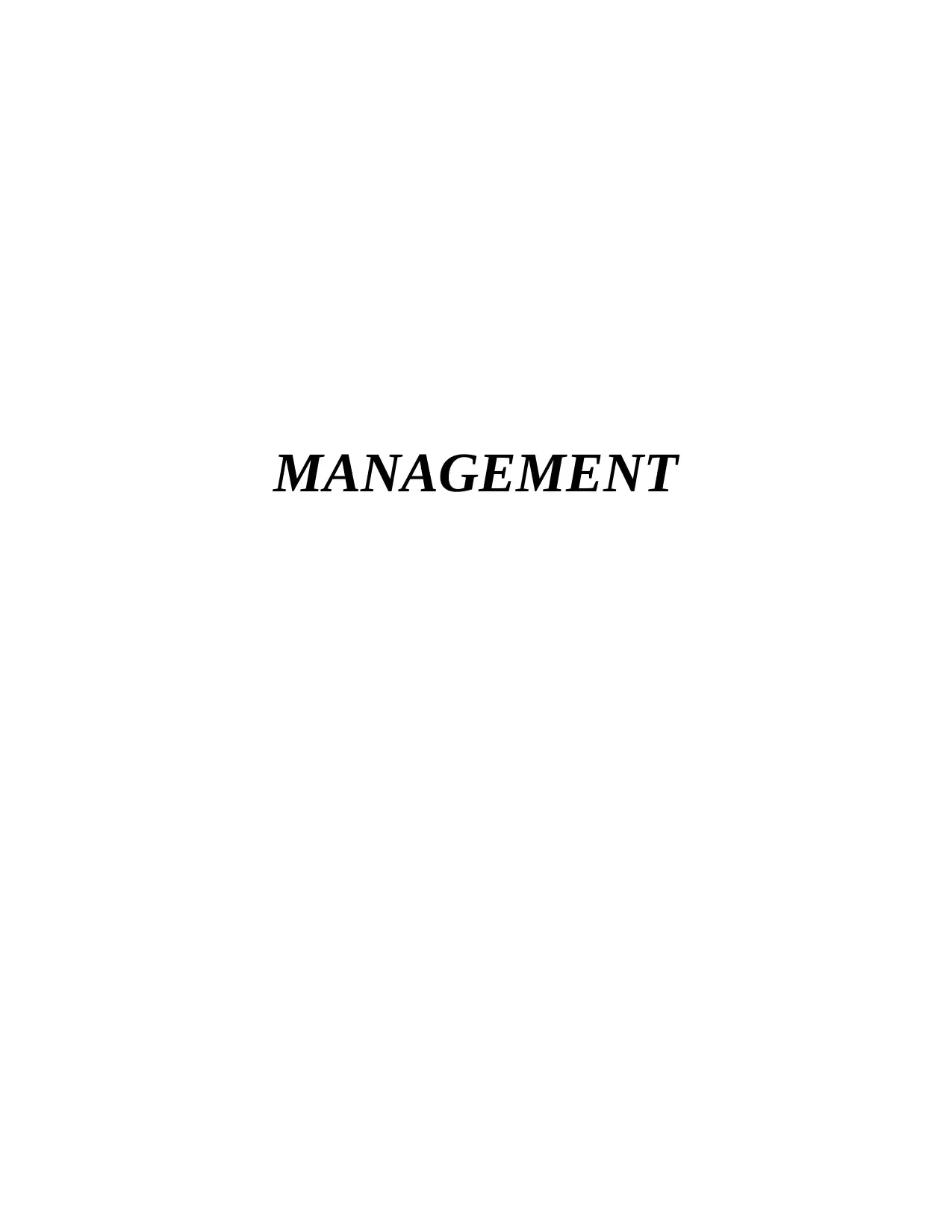
MANAGEMENT
Paraphrase This Document
Need a fresh take? Get an instant paraphrase of this document with our AI Paraphraser
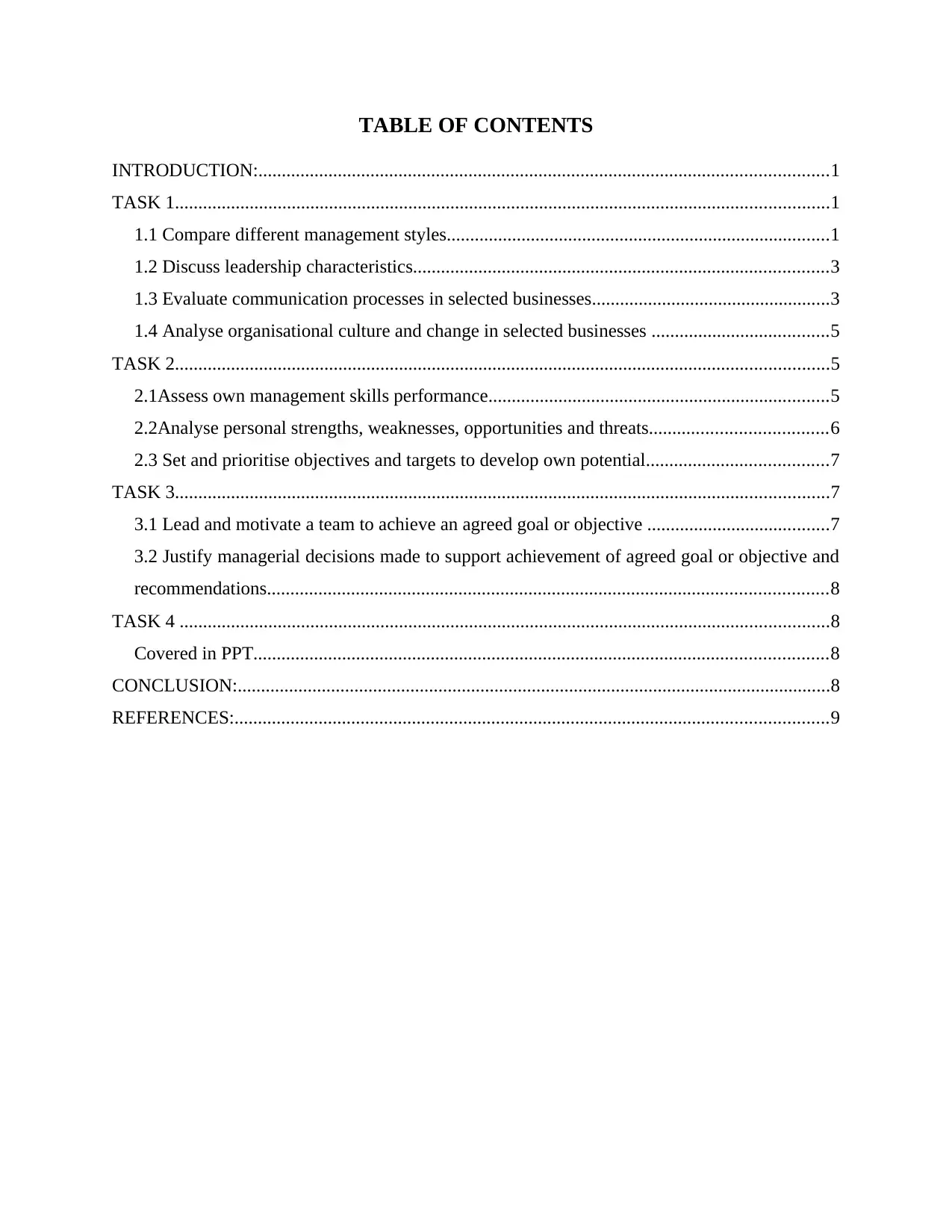
TABLE OF CONTENTS
INTRODUCTION:..........................................................................................................................1
TASK 1............................................................................................................................................1
1.1 Compare different management styles..................................................................................1
1.2 Discuss leadership characteristics.........................................................................................3
1.3 Evaluate communication processes in selected businesses...................................................3
1.4 Analyse organisational culture and change in selected businesses ......................................5
TASK 2............................................................................................................................................5
2.1Assess own management skills performance.........................................................................5
2.2Analyse personal strengths, weaknesses, opportunities and threats......................................6
2.3 Set and prioritise objectives and targets to develop own potential.......................................7
TASK 3............................................................................................................................................7
3.1 Lead and motivate a team to achieve an agreed goal or objective .......................................7
3.2 Justify managerial decisions made to support achievement of agreed goal or objective and
recommendations........................................................................................................................8
TASK 4 ...........................................................................................................................................8
Covered in PPT...........................................................................................................................8
CONCLUSION:...............................................................................................................................8
REFERENCES:...............................................................................................................................9
INTRODUCTION:..........................................................................................................................1
TASK 1............................................................................................................................................1
1.1 Compare different management styles..................................................................................1
1.2 Discuss leadership characteristics.........................................................................................3
1.3 Evaluate communication processes in selected businesses...................................................3
1.4 Analyse organisational culture and change in selected businesses ......................................5
TASK 2............................................................................................................................................5
2.1Assess own management skills performance.........................................................................5
2.2Analyse personal strengths, weaknesses, opportunities and threats......................................6
2.3 Set and prioritise objectives and targets to develop own potential.......................................7
TASK 3............................................................................................................................................7
3.1 Lead and motivate a team to achieve an agreed goal or objective .......................................7
3.2 Justify managerial decisions made to support achievement of agreed goal or objective and
recommendations........................................................................................................................8
TASK 4 ...........................................................................................................................................8
Covered in PPT...........................................................................................................................8
CONCLUSION:...............................................................................................................................8
REFERENCES:...............................................................................................................................9
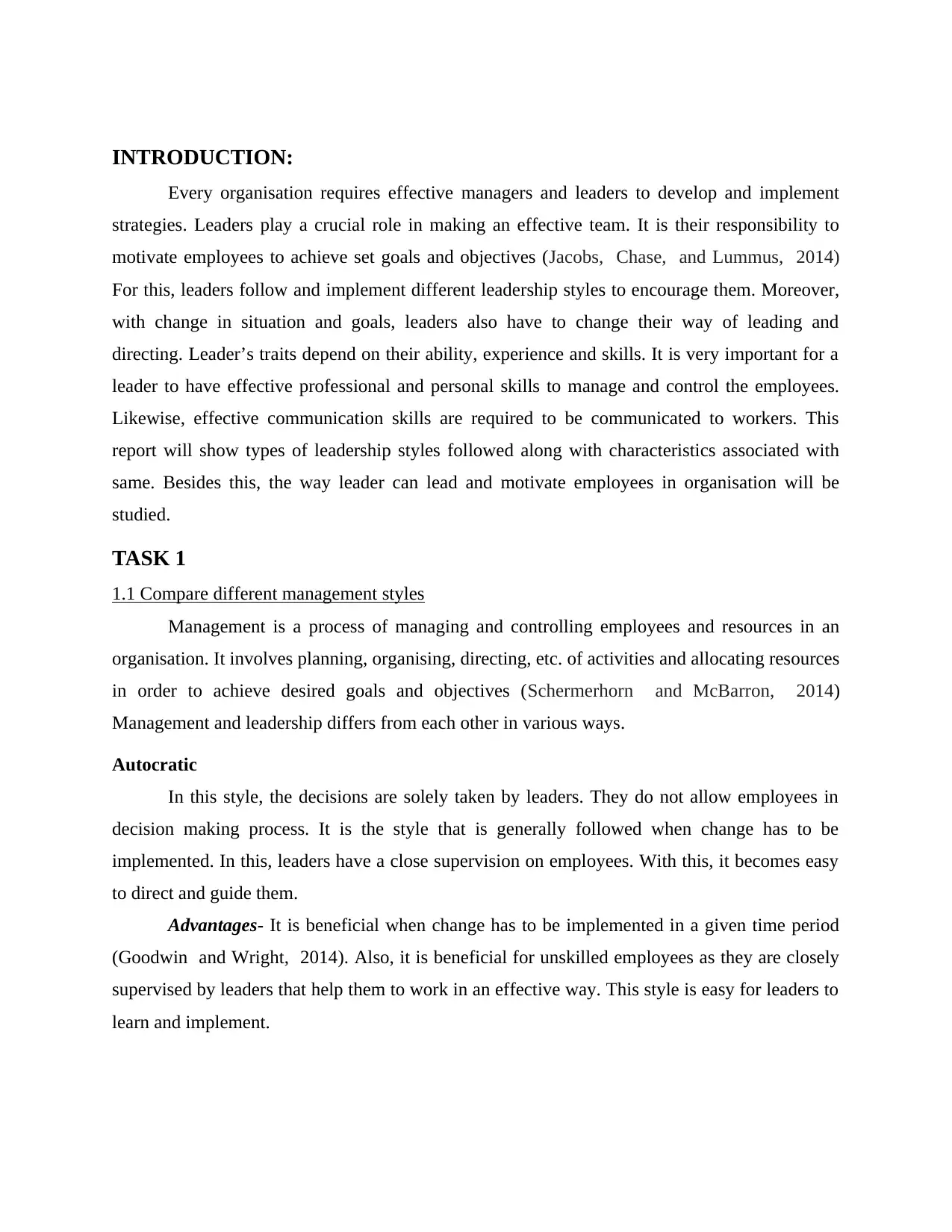
INTRODUCTION:
Every organisation requires effective managers and leaders to develop and implement
strategies. Leaders play a crucial role in making an effective team. It is their responsibility to
motivate employees to achieve set goals and objectives (Jacobs, Chase, and Lummus, 2014)
For this, leaders follow and implement different leadership styles to encourage them. Moreover,
with change in situation and goals, leaders also have to change their way of leading and
directing. Leader’s traits depend on their ability, experience and skills. It is very important for a
leader to have effective professional and personal skills to manage and control the employees.
Likewise, effective communication skills are required to be communicated to workers. This
report will show types of leadership styles followed along with characteristics associated with
same. Besides this, the way leader can lead and motivate employees in organisation will be
studied.
TASK 1
1.1 Compare different management styles
Management is a process of managing and controlling employees and resources in an
organisation. It involves planning, organising, directing, etc. of activities and allocating resources
in order to achieve desired goals and objectives (Schermerhorn and McBarron, 2014)
Management and leadership differs from each other in various ways.
Autocratic
In this style, the decisions are solely taken by leaders. They do not allow employees in
decision making process. It is the style that is generally followed when change has to be
implemented. In this, leaders have a close supervision on employees. With this, it becomes easy
to direct and guide them.
Advantages- It is beneficial when change has to be implemented in a given time period
(Goodwin and Wright, 2014). Also, it is beneficial for unskilled employees as they are closely
supervised by leaders that help them to work in an effective way. This style is easy for leaders to
learn and implement.
Every organisation requires effective managers and leaders to develop and implement
strategies. Leaders play a crucial role in making an effective team. It is their responsibility to
motivate employees to achieve set goals and objectives (Jacobs, Chase, and Lummus, 2014)
For this, leaders follow and implement different leadership styles to encourage them. Moreover,
with change in situation and goals, leaders also have to change their way of leading and
directing. Leader’s traits depend on their ability, experience and skills. It is very important for a
leader to have effective professional and personal skills to manage and control the employees.
Likewise, effective communication skills are required to be communicated to workers. This
report will show types of leadership styles followed along with characteristics associated with
same. Besides this, the way leader can lead and motivate employees in organisation will be
studied.
TASK 1
1.1 Compare different management styles
Management is a process of managing and controlling employees and resources in an
organisation. It involves planning, organising, directing, etc. of activities and allocating resources
in order to achieve desired goals and objectives (Schermerhorn and McBarron, 2014)
Management and leadership differs from each other in various ways.
Autocratic
In this style, the decisions are solely taken by leaders. They do not allow employees in
decision making process. It is the style that is generally followed when change has to be
implemented. In this, leaders have a close supervision on employees. With this, it becomes easy
to direct and guide them.
Advantages- It is beneficial when change has to be implemented in a given time period
(Goodwin and Wright, 2014). Also, it is beneficial for unskilled employees as they are closely
supervised by leaders that help them to work in an effective way. This style is easy for leaders to
learn and implement.
⊘ This is a preview!⊘
Do you want full access?
Subscribe today to unlock all pages.

Trusted by 1+ million students worldwide
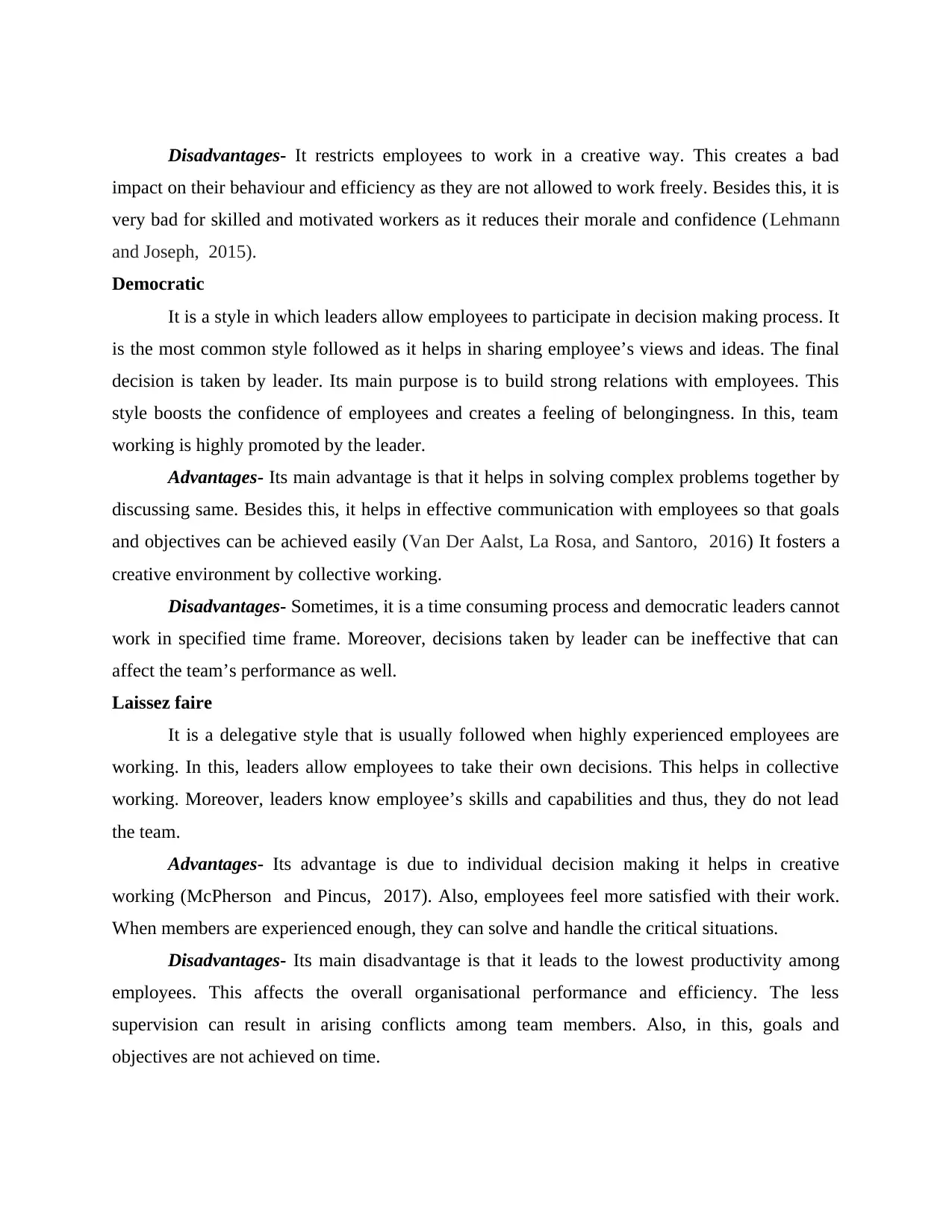
Disadvantages- It restricts employees to work in a creative way. This creates a bad
impact on their behaviour and efficiency as they are not allowed to work freely. Besides this, it is
very bad for skilled and motivated workers as it reduces their morale and confidence (Lehmann
and Joseph, 2015).
Democratic
It is a style in which leaders allow employees to participate in decision making process. It
is the most common style followed as it helps in sharing employee’s views and ideas. The final
decision is taken by leader. Its main purpose is to build strong relations with employees. This
style boosts the confidence of employees and creates a feeling of belongingness. In this, team
working is highly promoted by the leader.
Advantages- Its main advantage is that it helps in solving complex problems together by
discussing same. Besides this, it helps in effective communication with employees so that goals
and objectives can be achieved easily (Van Der Aalst, La Rosa, and Santoro, 2016) It fosters a
creative environment by collective working.
Disadvantages- Sometimes, it is a time consuming process and democratic leaders cannot
work in specified time frame. Moreover, decisions taken by leader can be ineffective that can
affect the team’s performance as well.
Laissez faire
It is a delegative style that is usually followed when highly experienced employees are
working. In this, leaders allow employees to take their own decisions. This helps in collective
working. Moreover, leaders know employee’s skills and capabilities and thus, they do not lead
the team.
Advantages- Its advantage is due to individual decision making it helps in creative
working (McPherson and Pincus, 2017). Also, employees feel more satisfied with their work.
When members are experienced enough, they can solve and handle the critical situations.
Disadvantages- Its main disadvantage is that it leads to the lowest productivity among
employees. This affects the overall organisational performance and efficiency. The less
supervision can result in arising conflicts among team members. Also, in this, goals and
objectives are not achieved on time.
impact on their behaviour and efficiency as they are not allowed to work freely. Besides this, it is
very bad for skilled and motivated workers as it reduces their morale and confidence (Lehmann
and Joseph, 2015).
Democratic
It is a style in which leaders allow employees to participate in decision making process. It
is the most common style followed as it helps in sharing employee’s views and ideas. The final
decision is taken by leader. Its main purpose is to build strong relations with employees. This
style boosts the confidence of employees and creates a feeling of belongingness. In this, team
working is highly promoted by the leader.
Advantages- Its main advantage is that it helps in solving complex problems together by
discussing same. Besides this, it helps in effective communication with employees so that goals
and objectives can be achieved easily (Van Der Aalst, La Rosa, and Santoro, 2016) It fosters a
creative environment by collective working.
Disadvantages- Sometimes, it is a time consuming process and democratic leaders cannot
work in specified time frame. Moreover, decisions taken by leader can be ineffective that can
affect the team’s performance as well.
Laissez faire
It is a delegative style that is usually followed when highly experienced employees are
working. In this, leaders allow employees to take their own decisions. This helps in collective
working. Moreover, leaders know employee’s skills and capabilities and thus, they do not lead
the team.
Advantages- Its advantage is due to individual decision making it helps in creative
working (McPherson and Pincus, 2017). Also, employees feel more satisfied with their work.
When members are experienced enough, they can solve and handle the critical situations.
Disadvantages- Its main disadvantage is that it leads to the lowest productivity among
employees. This affects the overall organisational performance and efficiency. The less
supervision can result in arising conflicts among team members. Also, in this, goals and
objectives are not achieved on time.
Paraphrase This Document
Need a fresh take? Get an instant paraphrase of this document with our AI Paraphraser
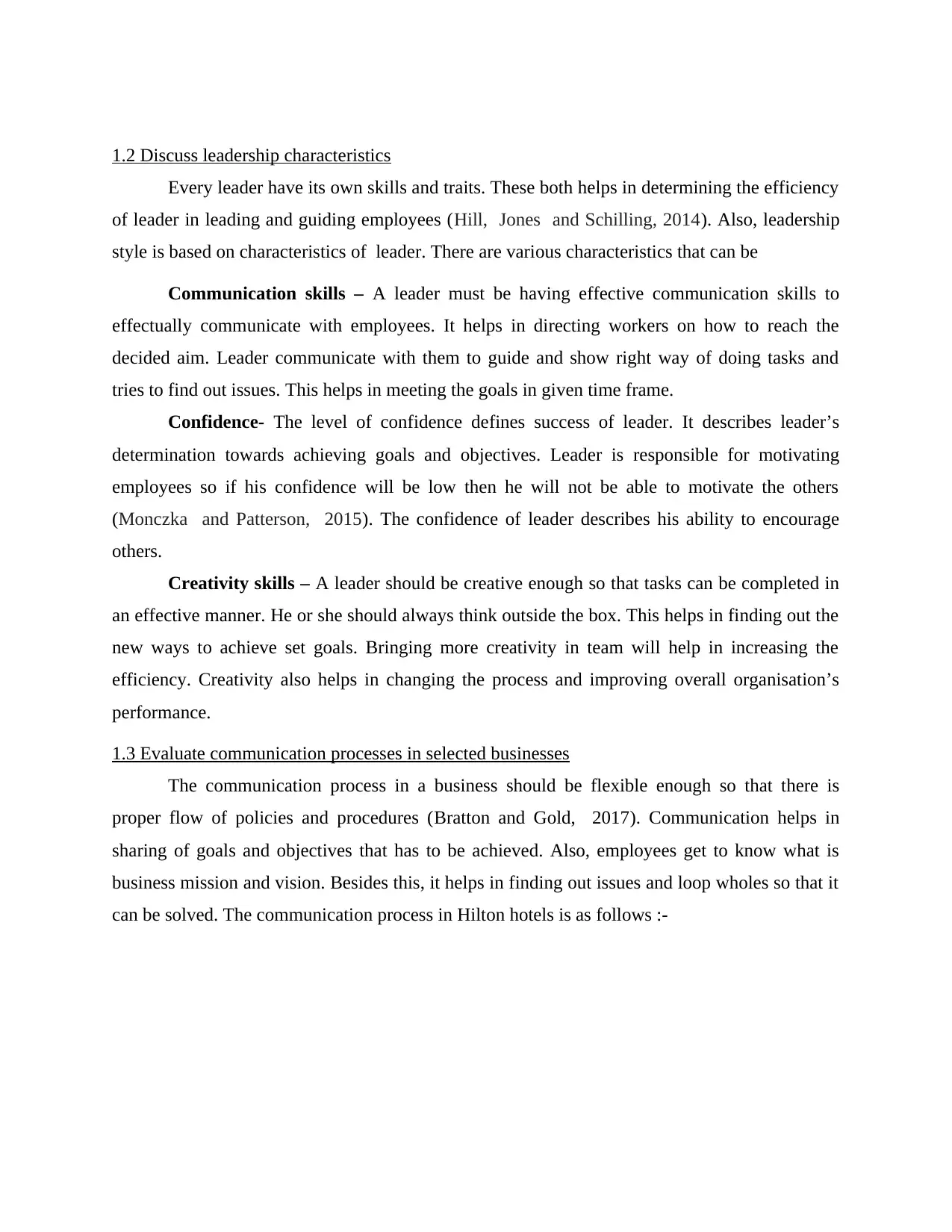
1.2 Discuss leadership characteristics
Every leader have its own skills and traits. These both helps in determining the efficiency
of leader in leading and guiding employees (Hill, Jones and Schilling, 2014). Also, leadership
style is based on characteristics of leader. There are various characteristics that can be
Communication skills – A leader must be having effective communication skills to
effectually communicate with employees. It helps in directing workers on how to reach the
decided aim. Leader communicate with them to guide and show right way of doing tasks and
tries to find out issues. This helps in meeting the goals in given time frame.
Confidence- The level of confidence defines success of leader. It describes leader’s
determination towards achieving goals and objectives. Leader is responsible for motivating
employees so if his confidence will be low then he will not be able to motivate the others
(Monczka and Patterson, 2015). The confidence of leader describes his ability to encourage
others.
Creativity skills – A leader should be creative enough so that tasks can be completed in
an effective manner. He or she should always think outside the box. This helps in finding out the
new ways to achieve set goals. Bringing more creativity in team will help in increasing the
efficiency. Creativity also helps in changing the process and improving overall organisation’s
performance.
1.3 Evaluate communication processes in selected businesses
The communication process in a business should be flexible enough so that there is
proper flow of policies and procedures (Bratton and Gold, 2017). Communication helps in
sharing of goals and objectives that has to be achieved. Also, employees get to know what is
business mission and vision. Besides this, it helps in finding out issues and loop wholes so that it
can be solved. The communication process in Hilton hotels is as follows :-
Every leader have its own skills and traits. These both helps in determining the efficiency
of leader in leading and guiding employees (Hill, Jones and Schilling, 2014). Also, leadership
style is based on characteristics of leader. There are various characteristics that can be
Communication skills – A leader must be having effective communication skills to
effectually communicate with employees. It helps in directing workers on how to reach the
decided aim. Leader communicate with them to guide and show right way of doing tasks and
tries to find out issues. This helps in meeting the goals in given time frame.
Confidence- The level of confidence defines success of leader. It describes leader’s
determination towards achieving goals and objectives. Leader is responsible for motivating
employees so if his confidence will be low then he will not be able to motivate the others
(Monczka and Patterson, 2015). The confidence of leader describes his ability to encourage
others.
Creativity skills – A leader should be creative enough so that tasks can be completed in
an effective manner. He or she should always think outside the box. This helps in finding out the
new ways to achieve set goals. Bringing more creativity in team will help in increasing the
efficiency. Creativity also helps in changing the process and improving overall organisation’s
performance.
1.3 Evaluate communication processes in selected businesses
The communication process in a business should be flexible enough so that there is
proper flow of policies and procedures (Bratton and Gold, 2017). Communication helps in
sharing of goals and objectives that has to be achieved. Also, employees get to know what is
business mission and vision. Besides this, it helps in finding out issues and loop wholes so that it
can be solved. The communication process in Hilton hotels is as follows :-
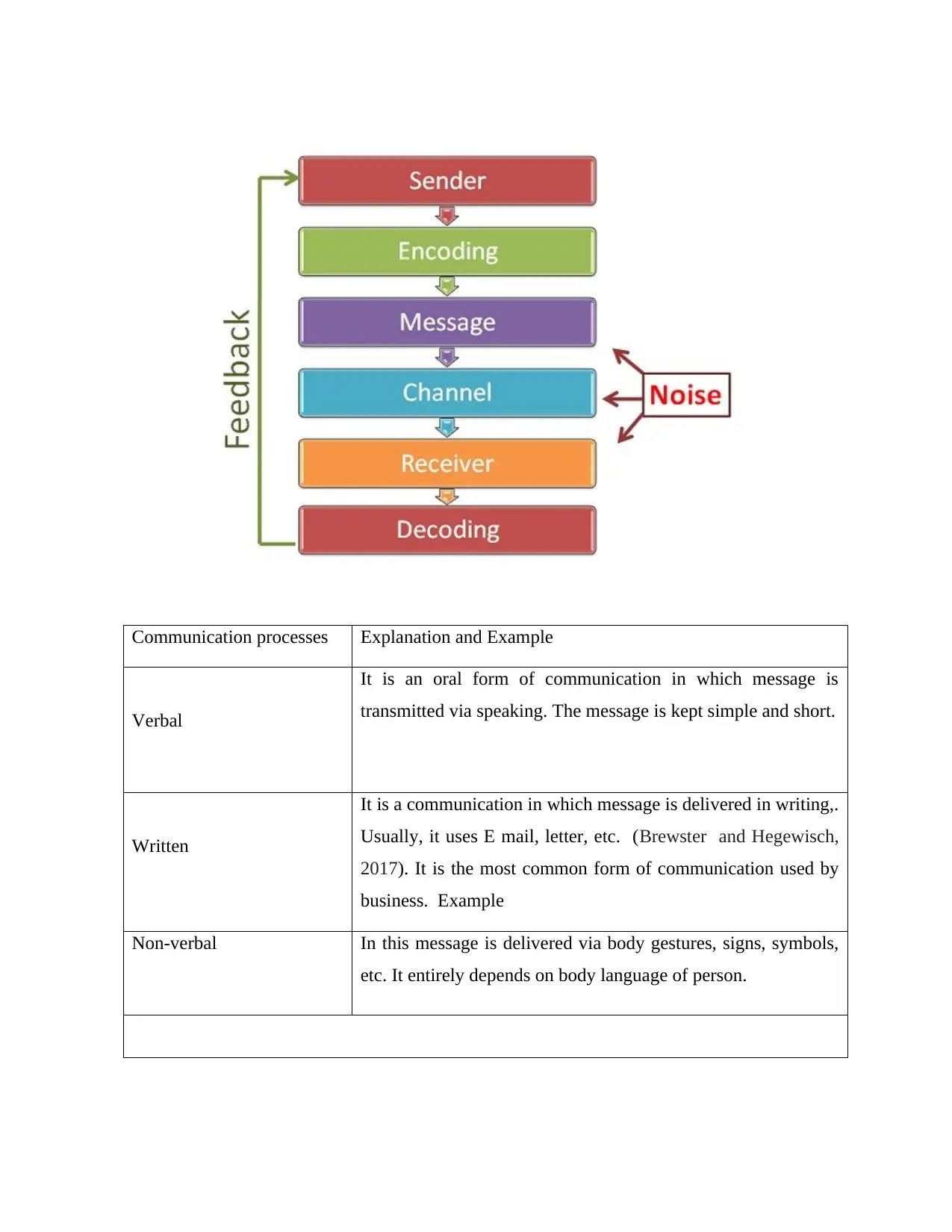
Communication processes Explanation and Example
Verbal
It is an oral form of communication in which message is
transmitted via speaking. The message is kept simple and short.
Written
It is a communication in which message is delivered in writing,.
Usually, it uses E mail, letter, etc. (Brewster and Hegewisch,
2017). It is the most common form of communication used by
business. Example
Non-verbal In this message is delivered via body gestures, signs, symbols,
etc. It entirely depends on body language of person.
Verbal
It is an oral form of communication in which message is
transmitted via speaking. The message is kept simple and short.
Written
It is a communication in which message is delivered in writing,.
Usually, it uses E mail, letter, etc. (Brewster and Hegewisch,
2017). It is the most common form of communication used by
business. Example
Non-verbal In this message is delivered via body gestures, signs, symbols,
etc. It entirely depends on body language of person.
⊘ This is a preview!⊘
Do you want full access?
Subscribe today to unlock all pages.

Trusted by 1+ million students worldwide
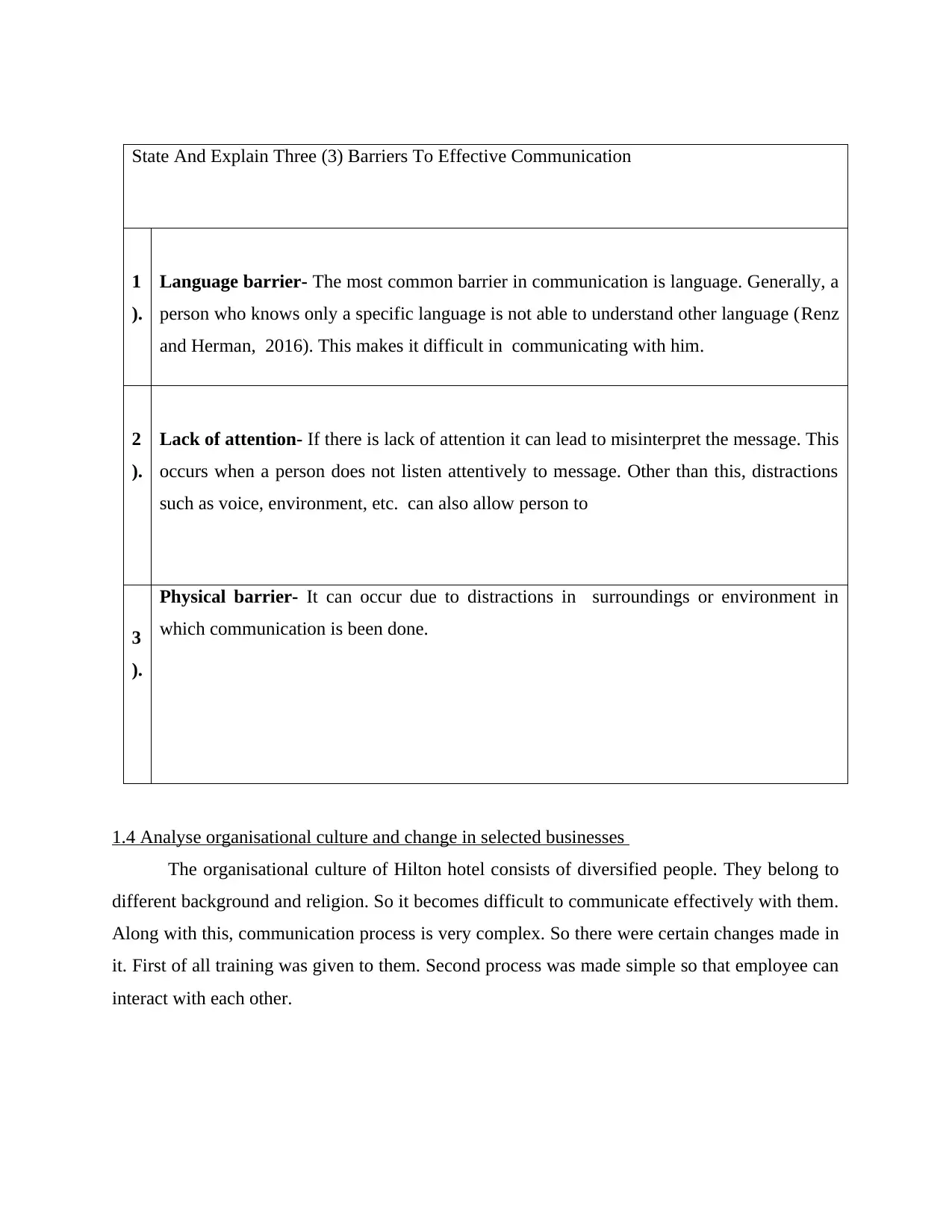
State And Explain Three (3) Barriers To Effective Communication
1
).
Language barrier- The most common barrier in communication is language. Generally, a
person who knows only a specific language is not able to understand other language (Renz
and Herman, 2016). This makes it difficult in communicating with him.
2
).
Lack of attention- If there is lack of attention it can lead to misinterpret the message. This
occurs when a person does not listen attentively to message. Other than this, distractions
such as voice, environment, etc. can also allow person to
3
).
Physical barrier- It can occur due to distractions in surroundings or environment in
which communication is been done.
1.4 Analyse organisational culture and change in selected businesses
The organisational culture of Hilton hotel consists of diversified people. They belong to
different background and religion. So it becomes difficult to communicate effectively with them.
Along with this, communication process is very complex. So there were certain changes made in
it. First of all training was given to them. Second process was made simple so that employee can
interact with each other.
1
).
Language barrier- The most common barrier in communication is language. Generally, a
person who knows only a specific language is not able to understand other language (Renz
and Herman, 2016). This makes it difficult in communicating with him.
2
).
Lack of attention- If there is lack of attention it can lead to misinterpret the message. This
occurs when a person does not listen attentively to message. Other than this, distractions
such as voice, environment, etc. can also allow person to
3
).
Physical barrier- It can occur due to distractions in surroundings or environment in
which communication is been done.
1.4 Analyse organisational culture and change in selected businesses
The organisational culture of Hilton hotel consists of diversified people. They belong to
different background and religion. So it becomes difficult to communicate effectively with them.
Along with this, communication process is very complex. So there were certain changes made in
it. First of all training was given to them. Second process was made simple so that employee can
interact with each other.
Paraphrase This Document
Need a fresh take? Get an instant paraphrase of this document with our AI Paraphraser
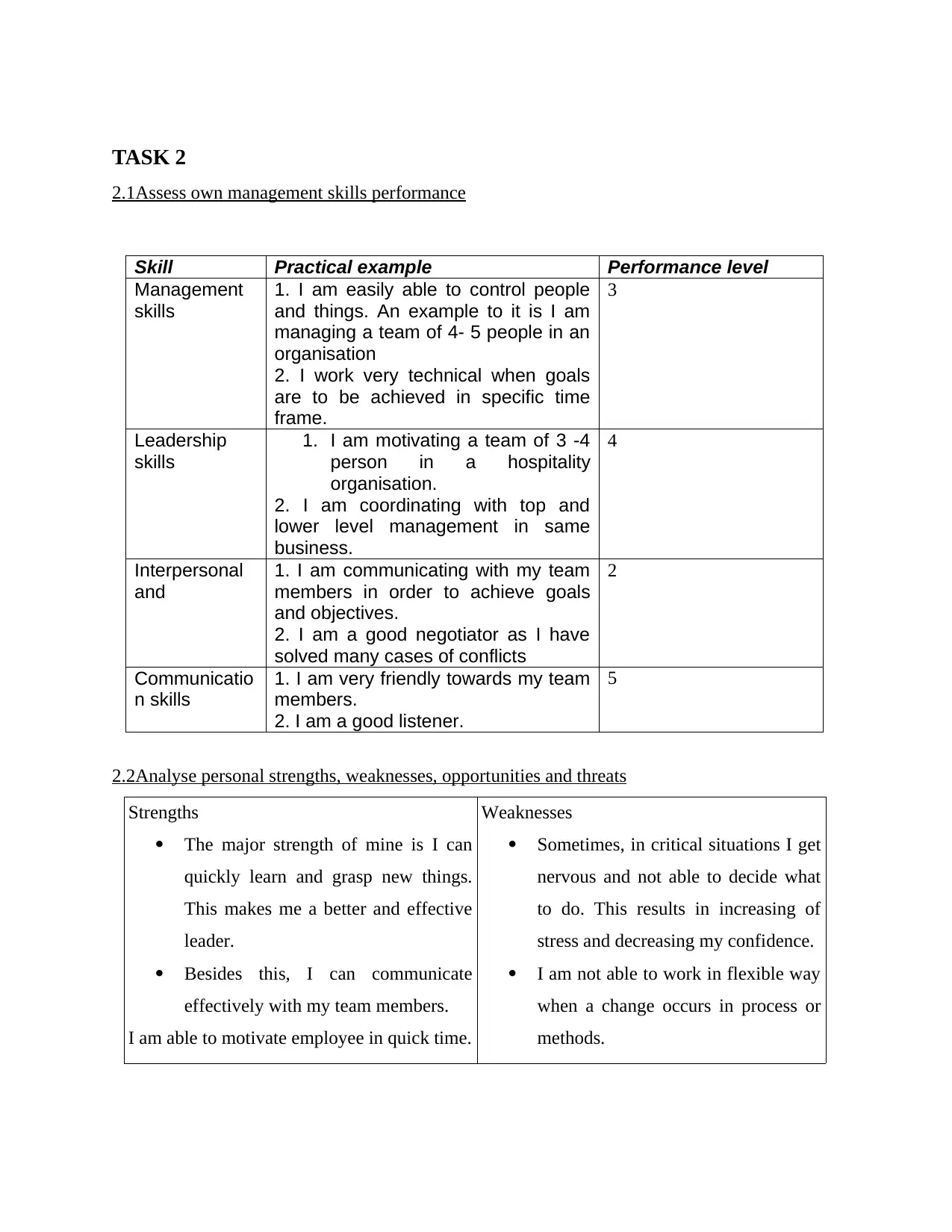
TASK 2
2.1Assess own management skills performance
Skill Practical example Performance level
Management
skills
1. I am easily able to control people
and things. An example to it is I am
managing a team of 4- 5 people in an
organisation
2. I work very technical when goals
are to be achieved in specific time
frame.
3
Leadership
skills
1. I am motivating a team of 3 -4
person in a hospitality
organisation.
2. I am coordinating with top and
lower level management in same
business.
4
Interpersonal
and
1. I am communicating with my team
members in order to achieve goals
and objectives.
2. I am a good negotiator as I have
solved many cases of conflicts
2
Communicatio
n skills
1. I am very friendly towards my team
members.
2. I am a good listener.
5
2.2Analyse personal strengths, weaknesses, opportunities and threats
Strengths
The major strength of mine is I can
quickly learn and grasp new things.
This makes me a better and effective
leader.
Besides this, I can communicate
effectively with my team members.
I am able to motivate employee in quick time.
Weaknesses
Sometimes, in critical situations I get
nervous and not able to decide what
to do. This results in increasing of
stress and decreasing my confidence.
I am not able to work in flexible way
when a change occurs in process or
methods.
2.1Assess own management skills performance
Skill Practical example Performance level
Management
skills
1. I am easily able to control people
and things. An example to it is I am
managing a team of 4- 5 people in an
organisation
2. I work very technical when goals
are to be achieved in specific time
frame.
3
Leadership
skills
1. I am motivating a team of 3 -4
person in a hospitality
organisation.
2. I am coordinating with top and
lower level management in same
business.
4
Interpersonal
and
1. I am communicating with my team
members in order to achieve goals
and objectives.
2. I am a good negotiator as I have
solved many cases of conflicts
2
Communicatio
n skills
1. I am very friendly towards my team
members.
2. I am a good listener.
5
2.2Analyse personal strengths, weaknesses, opportunities and threats
Strengths
The major strength of mine is I can
quickly learn and grasp new things.
This makes me a better and effective
leader.
Besides this, I can communicate
effectively with my team members.
I am able to motivate employee in quick time.
Weaknesses
Sometimes, in critical situations I get
nervous and not able to decide what
to do. This results in increasing of
stress and decreasing my confidence.
I am not able to work in flexible way
when a change occurs in process or
methods.
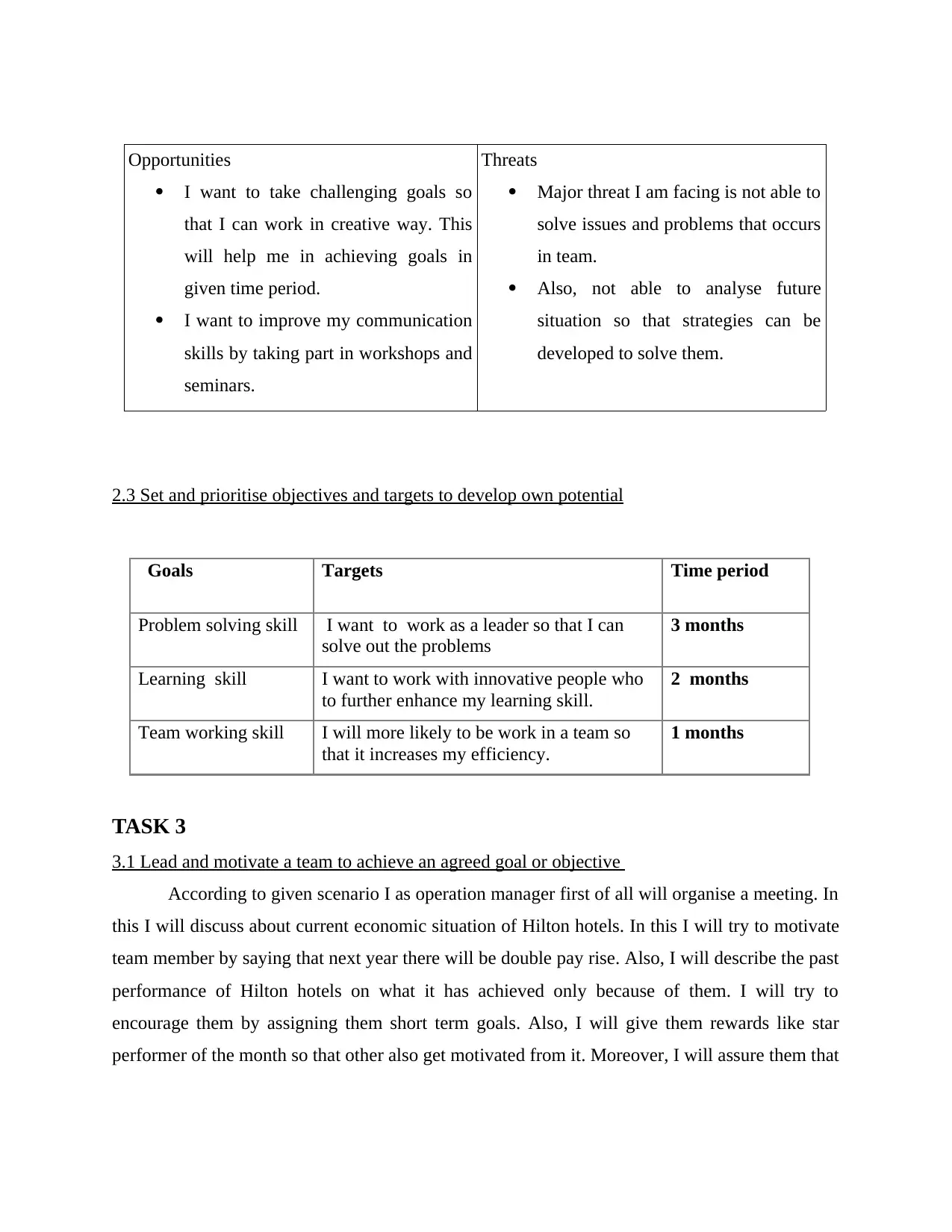
Opportunities
I want to take challenging goals so
that I can work in creative way. This
will help me in achieving goals in
given time period.
I want to improve my communication
skills by taking part in workshops and
seminars.
Threats
Major threat I am facing is not able to
solve issues and problems that occurs
in team.
Also, not able to analyse future
situation so that strategies can be
developed to solve them.
2.3 Set and prioritise objectives and targets to develop own potential
Goals Targets Time period
Problem solving skill I want to work as a leader so that I can
solve out the problems
3 months
Learning skill I want to work with innovative people who
to further enhance my learning skill.
2 months
Team working skill I will more likely to be work in a team so
that it increases my efficiency.
1 months
TASK 3
3.1 Lead and motivate a team to achieve an agreed goal or objective
According to given scenario I as operation manager first of all will organise a meeting. In
this I will discuss about current economic situation of Hilton hotels. In this I will try to motivate
team member by saying that next year there will be double pay rise. Also, I will describe the past
performance of Hilton hotels on what it has achieved only because of them. I will try to
encourage them by assigning them short term goals. Also, I will give them rewards like star
performer of the month so that other also get motivated from it. Moreover, I will assure them that
I want to take challenging goals so
that I can work in creative way. This
will help me in achieving goals in
given time period.
I want to improve my communication
skills by taking part in workshops and
seminars.
Threats
Major threat I am facing is not able to
solve issues and problems that occurs
in team.
Also, not able to analyse future
situation so that strategies can be
developed to solve them.
2.3 Set and prioritise objectives and targets to develop own potential
Goals Targets Time period
Problem solving skill I want to work as a leader so that I can
solve out the problems
3 months
Learning skill I want to work with innovative people who
to further enhance my learning skill.
2 months
Team working skill I will more likely to be work in a team so
that it increases my efficiency.
1 months
TASK 3
3.1 Lead and motivate a team to achieve an agreed goal or objective
According to given scenario I as operation manager first of all will organise a meeting. In
this I will discuss about current economic situation of Hilton hotels. In this I will try to motivate
team member by saying that next year there will be double pay rise. Also, I will describe the past
performance of Hilton hotels on what it has achieved only because of them. I will try to
encourage them by assigning them short term goals. Also, I will give them rewards like star
performer of the month so that other also get motivated from it. Moreover, I will assure them that
⊘ This is a preview!⊘
Do you want full access?
Subscribe today to unlock all pages.

Trusted by 1+ million students worldwide
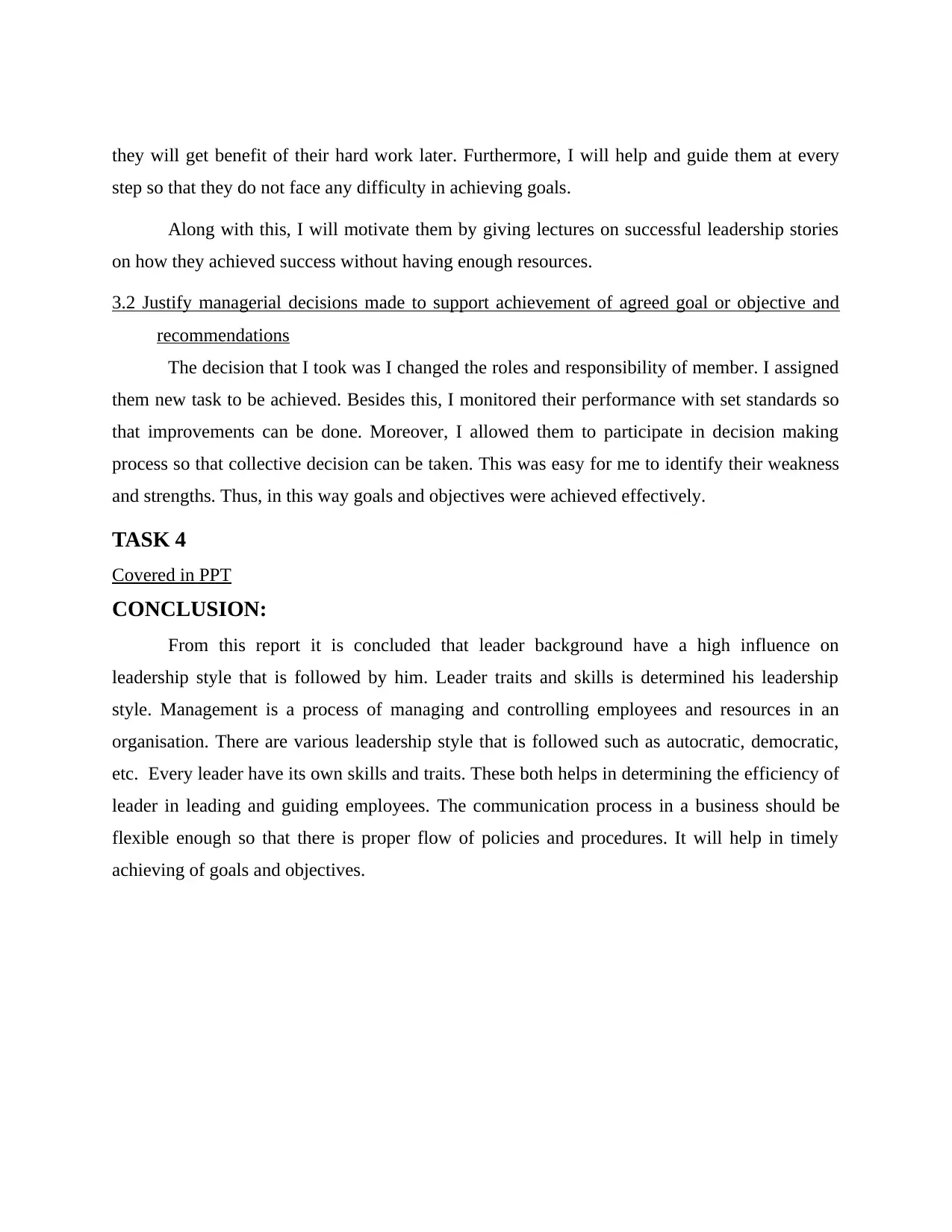
they will get benefit of their hard work later. Furthermore, I will help and guide them at every
step so that they do not face any difficulty in achieving goals.
Along with this, I will motivate them by giving lectures on successful leadership stories
on how they achieved success without having enough resources.
3.2 Justify managerial decisions made to support achievement of agreed goal or objective and
recommendations
The decision that I took was I changed the roles and responsibility of member. I assigned
them new task to be achieved. Besides this, I monitored their performance with set standards so
that improvements can be done. Moreover, I allowed them to participate in decision making
process so that collective decision can be taken. This was easy for me to identify their weakness
and strengths. Thus, in this way goals and objectives were achieved effectively.
TASK 4
Covered in PPT
CONCLUSION:
From this report it is concluded that leader background have a high influence on
leadership style that is followed by him. Leader traits and skills is determined his leadership
style. Management is a process of managing and controlling employees and resources in an
organisation. There are various leadership style that is followed such as autocratic, democratic,
etc. Every leader have its own skills and traits. These both helps in determining the efficiency of
leader in leading and guiding employees. The communication process in a business should be
flexible enough so that there is proper flow of policies and procedures. It will help in timely
achieving of goals and objectives.
step so that they do not face any difficulty in achieving goals.
Along with this, I will motivate them by giving lectures on successful leadership stories
on how they achieved success without having enough resources.
3.2 Justify managerial decisions made to support achievement of agreed goal or objective and
recommendations
The decision that I took was I changed the roles and responsibility of member. I assigned
them new task to be achieved. Besides this, I monitored their performance with set standards so
that improvements can be done. Moreover, I allowed them to participate in decision making
process so that collective decision can be taken. This was easy for me to identify their weakness
and strengths. Thus, in this way goals and objectives were achieved effectively.
TASK 4
Covered in PPT
CONCLUSION:
From this report it is concluded that leader background have a high influence on
leadership style that is followed by him. Leader traits and skills is determined his leadership
style. Management is a process of managing and controlling employees and resources in an
organisation. There are various leadership style that is followed such as autocratic, democratic,
etc. Every leader have its own skills and traits. These both helps in determining the efficiency of
leader in leading and guiding employees. The communication process in a business should be
flexible enough so that there is proper flow of policies and procedures. It will help in timely
achieving of goals and objectives.
Paraphrase This Document
Need a fresh take? Get an instant paraphrase of this document with our AI Paraphraser
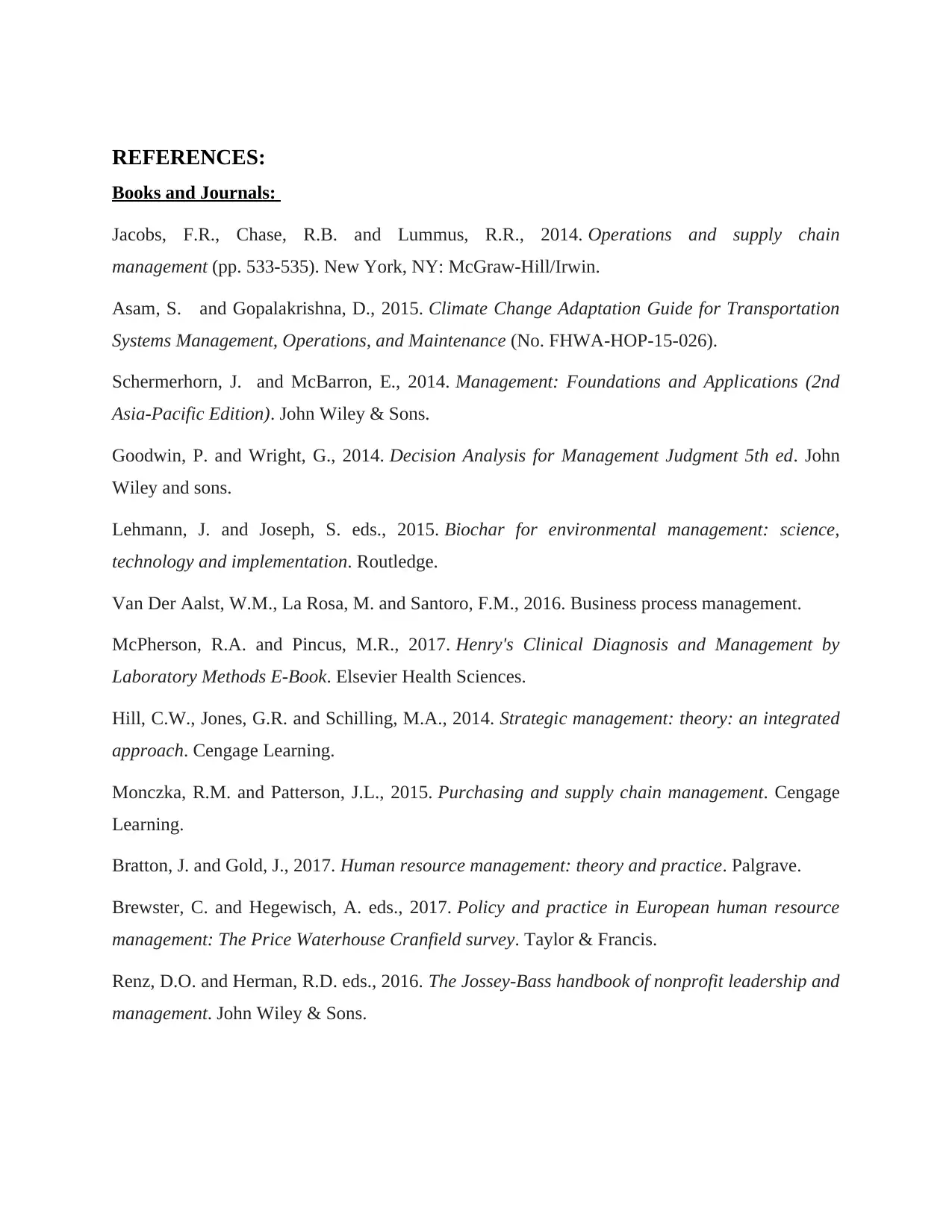
REFERENCES:
Books and Journals:
Jacobs, F.R., Chase, R.B. and Lummus, R.R., 2014. Operations and supply chain
management (pp. 533-535). New York, NY: McGraw-Hill/Irwin.
Asam, S. and Gopalakrishna, D., 2015. Climate Change Adaptation Guide for Transportation
Systems Management, Operations, and Maintenance (No. FHWA-HOP-15-026).
Schermerhorn, J. and McBarron, E., 2014. Management: Foundations and Applications (2nd
Asia-Pacific Edition). John Wiley & Sons.
Goodwin, P. and Wright, G., 2014. Decision Analysis for Management Judgment 5th ed. John
Wiley and sons.
Lehmann, J. and Joseph, S. eds., 2015. Biochar for environmental management: science,
technology and implementation. Routledge.
Van Der Aalst, W.M., La Rosa, M. and Santoro, F.M., 2016. Business process management.
McPherson, R.A. and Pincus, M.R., 2017. Henry's Clinical Diagnosis and Management by
Laboratory Methods E-Book. Elsevier Health Sciences.
Hill, C.W., Jones, G.R. and Schilling, M.A., 2014. Strategic management: theory: an integrated
approach. Cengage Learning.
Monczka, R.M. and Patterson, J.L., 2015. Purchasing and supply chain management. Cengage
Learning.
Bratton, J. and Gold, J., 2017. Human resource management: theory and practice. Palgrave.
Brewster, C. and Hegewisch, A. eds., 2017. Policy and practice in European human resource
management: The Price Waterhouse Cranfield survey. Taylor & Francis.
Renz, D.O. and Herman, R.D. eds., 2016. The Jossey-Bass handbook of nonprofit leadership and
management. John Wiley & Sons.
Books and Journals:
Jacobs, F.R., Chase, R.B. and Lummus, R.R., 2014. Operations and supply chain
management (pp. 533-535). New York, NY: McGraw-Hill/Irwin.
Asam, S. and Gopalakrishna, D., 2015. Climate Change Adaptation Guide for Transportation
Systems Management, Operations, and Maintenance (No. FHWA-HOP-15-026).
Schermerhorn, J. and McBarron, E., 2014. Management: Foundations and Applications (2nd
Asia-Pacific Edition). John Wiley & Sons.
Goodwin, P. and Wright, G., 2014. Decision Analysis for Management Judgment 5th ed. John
Wiley and sons.
Lehmann, J. and Joseph, S. eds., 2015. Biochar for environmental management: science,
technology and implementation. Routledge.
Van Der Aalst, W.M., La Rosa, M. and Santoro, F.M., 2016. Business process management.
McPherson, R.A. and Pincus, M.R., 2017. Henry's Clinical Diagnosis and Management by
Laboratory Methods E-Book. Elsevier Health Sciences.
Hill, C.W., Jones, G.R. and Schilling, M.A., 2014. Strategic management: theory: an integrated
approach. Cengage Learning.
Monczka, R.M. and Patterson, J.L., 2015. Purchasing and supply chain management. Cengage
Learning.
Bratton, J. and Gold, J., 2017. Human resource management: theory and practice. Palgrave.
Brewster, C. and Hegewisch, A. eds., 2017. Policy and practice in European human resource
management: The Price Waterhouse Cranfield survey. Taylor & Francis.
Renz, D.O. and Herman, R.D. eds., 2016. The Jossey-Bass handbook of nonprofit leadership and
management. John Wiley & Sons.
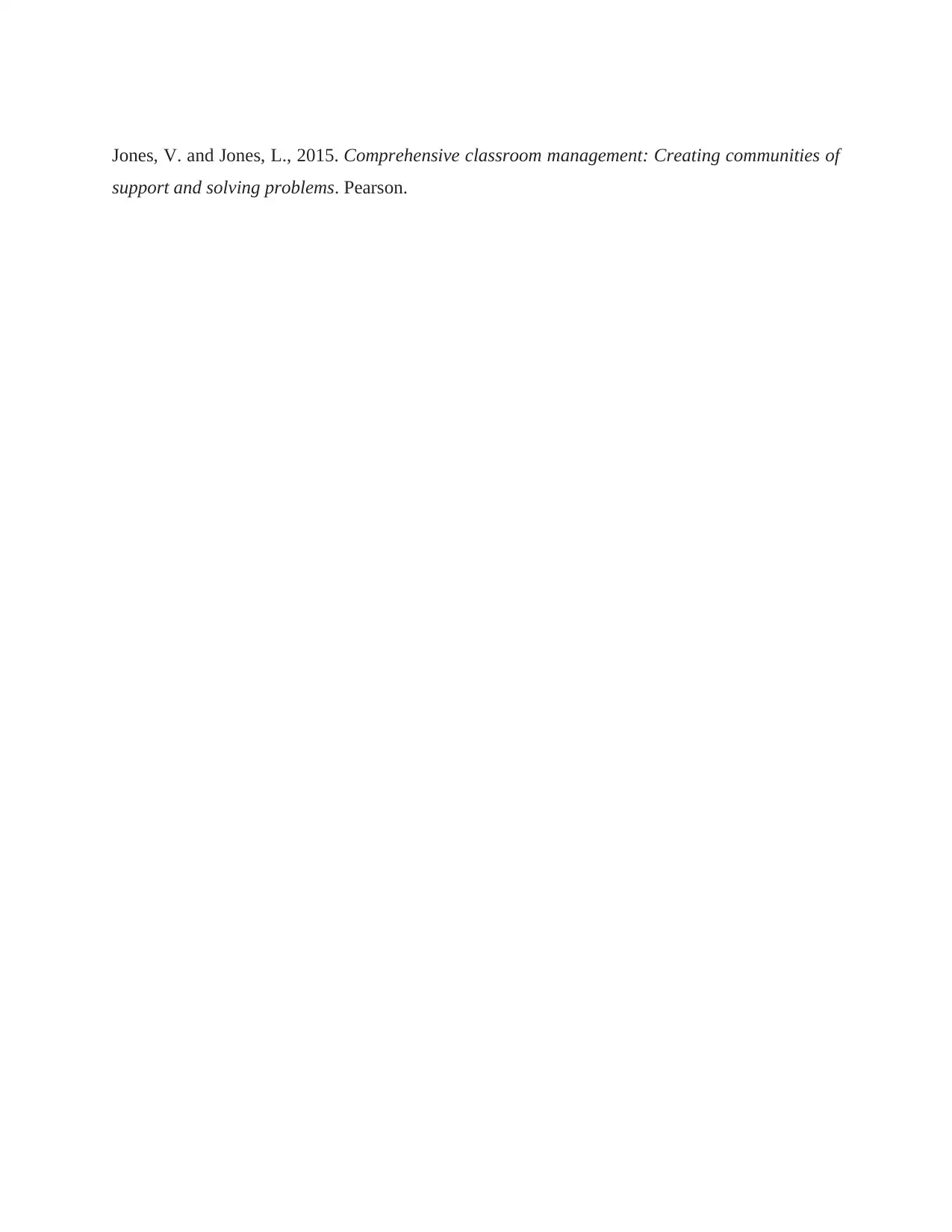
Jones, V. and Jones, L., 2015. Comprehensive classroom management: Creating communities of
support and solving problems. Pearson.
support and solving problems. Pearson.
⊘ This is a preview!⊘
Do you want full access?
Subscribe today to unlock all pages.

Trusted by 1+ million students worldwide
1 out of 12
Related Documents
Your All-in-One AI-Powered Toolkit for Academic Success.
+13062052269
info@desklib.com
Available 24*7 on WhatsApp / Email
![[object Object]](/_next/static/media/star-bottom.7253800d.svg)
Unlock your academic potential
Copyright © 2020–2025 A2Z Services. All Rights Reserved. Developed and managed by ZUCOL.





